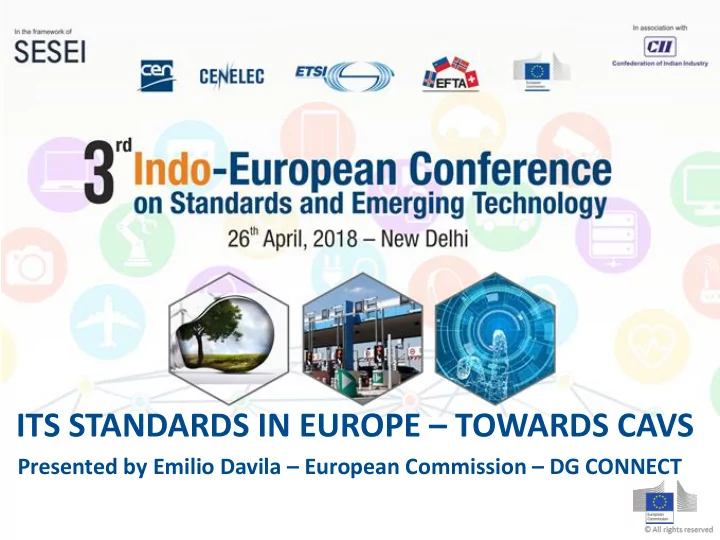

ITS STANDARDS IN EUROPE – TOWARDS CAVS Presented by Emilio Davila – European Commission – DG CONNECT
ITS STANDARDISATION IN EUROPE TOWARDS CONNECTED AND AUTOMATED MOBILITY ❖ ITS standards – Support to EU policies ❖ How to achieve it ❖ EC support to standardisation ❖ The case of eCall ❖ International cooperation
ITS Standards and European Policies • Roadmap to a Single European Transport Area Towards a competitive and resource efficient transport system • To meet the challenges , transport has to: • Use less energy • Use cleaner energy • Exploit efficiently a multimodal, integrated and ‘intelligent’ network • Curbing mobility is not an option • By 2050 reduce emissions by 60%, and 20% by 2020 (2008 level) • By 2050 move close to zero fatalities in road transport, halving road casualties by 2020 DAE: "Every Car Digital, Every Car Connected"
WHY DO WE NEED ITS STANDARDS? • Encourage innovation , foster enterprise and open up new markets for suppliers • Create trust and confidence in products and services • Expand the market , brings down costs and increases competition • Helps to prevent duplication of effort • Supports greater confidence in procurement • Interchangeability of system component suppliers • Enable interoperability of systems/services
HOW TO ACHIEVE IT: COOPERATION ✓ Active and fair involvement of all the relevant stakeholders ✓ Support from RTD projects, validation and fine- tuning through field operational tests, pilots ✓ Cooperation among the different standardisation organisations and groups ✓ International cooperation
EC SUPPORT TO STANDARDISATION Instruments: • Setting of the priorities : ITS Directive legal Framework (2010/40), Radiospectrum Decision 2008/671/EC; Communications (EU-C-ITS Strategy, 5G AP) • Research Framework program/ H2020/ CIP / C-Roads / PPP • EC Mandates for standardisation Groups: • ITS Committee; ITS Advisory group • ITS Standardisation Coordination Group • iMobility Forum • C-ITS Platform • EATA, 5GPPP Support to International Cooperation Funding of standardisation activities: • Mandates and ICT Standardisation Rolling Plan • Specialist Task Forces on EETS • Specialist Task Forces on coop. systems • Specialist Task Forces on eCall • Specialist Task Forces on Urban ITS • Results from EU funded RTF projects/FOTs/Pilots
CAVs: Road CAVs: Road to Deployment to Deployment C-ITS ITS AP ITS Platform Directive European ITS Advisory Group VSC WG Report M/453 Release 1 M/453 Rolling F.R. TC 278 Rolling Plan WG16 Plan 2 ITSsV6 2002 2003 2004 2005 2006 2007 2008 2009 2010 2011 2012 2013 2014 2015
CAVs: Road CAVs: Road to Deployment to Deployment RSCOM Rolling Plan Mandate Rolling -V Plan Rolling Plan FR Phase I C-ITS Platform FR Phase II 5G EU Corridors M/ 546 C-ITS Platform CEFs Projects 2018 2019 2020 2016 2017
CAVs standardisation overview Stakeholders Groups ITS Standardisation C-ITS Global Platform Coordination Group EC Monitoring Cooperation Coordination M/ 453 AIOTI M/ 546 2 Cooperation International Results ITSsV6 Validation & Feedback European HTG Cooperation EU and national funded projects
CEN TS/prEN 16454 ✓ - Public service 112-based only eCall end to end conformance testing -Voice + MSD to relevant PSAP ✓ - 112-based, with or without EN 16072 intermediation platform under Public delegation Pan-European eCall Operating Requirements ETSI-MSG & 3GPP. Chair: N. Sampson ✓ High Level Application Protocols EN 16062 ✓ ✓ ETSI TS 122 101 In-band modem trx - Voice + MSD on 112 eCall NAD conformance specs: ETSI TS 126 267 ✓ “eCall Data Transfer - ✓ ✓ ETSI TS 102 936-1 General Description EN 15722 Protocol test specification ✓ ETSI TS 124 008 ✓ ETSI TS 126 268 MSD Table 10.5.135d ETSI TS 102 936-2 ✓ ✓ ✓ “eCall Data Transfer. eCall Flag Test Suites ✓ ANSI-C Reference Code ETSI TR 102 937 ✓ ETSI TS 126 269 eCall Comm. equipment: “eCall Data Transfer. Data registry procedures ✓ Conformance to EU regulations Conformance testing - ISO/EN 24978:2009 CEN TC 278 WG 15. Chair Bob Williams ETSI TR 126 969 ✓ EN 16102 “eCall Data Transfer. Characterisation Report TPS-eCall Operating Requirements
International Cooperation Global harmonisation of standards for Benefits : Cooperative Systems ✓ reducing development costs ✓ getting to global markets Memorandum of Cooperation agreed between ETSI and U.S. DoT RITA ✓ avoiding duplication of efforts ✓ generating economies of scale Harmonization Action Plan process for finalising internationally harmonized standards Harmonization Principles suggest policies to be followed in the harmonization Harmonization Task Groups (HTGs): HTG1: Management and security (complete) HTG2: Vehicle Safety Message (complete) HTG3: 5.9GHz protocol harmonization (complete) HTG4: Roadside messages (under way) HTG5: Intersection messages (under way) HTG6: Security Policy (started Jan 2014) HTG reports issued and being applied by SDOs. Available on EU/US official sites: http://www.its.dot.gov/connected_vehicle/international_research.htm http://ec.europa.eu/digital-agenda/en/news/progress-and-findings-harmonisation- eu-us-security-and-communications-standards-field MoC with Japan (MLIT) Source: COMeSafety2 project
CONCLUSIONS ✓ CAVs have the potential to contribute tackling the mobility challenges in Europe and worldwide ✓ Standards are needed for wide take-up of ITS ✓ Stakeholders and SDOs cooperation is paramount ✓ Importance of international cooperation/ global harmonisation ✓ Release 1 important milestone. In the right track towards deployment. Pilots and pre-deployment.
Thank you for your attention
Recommend
More recommend